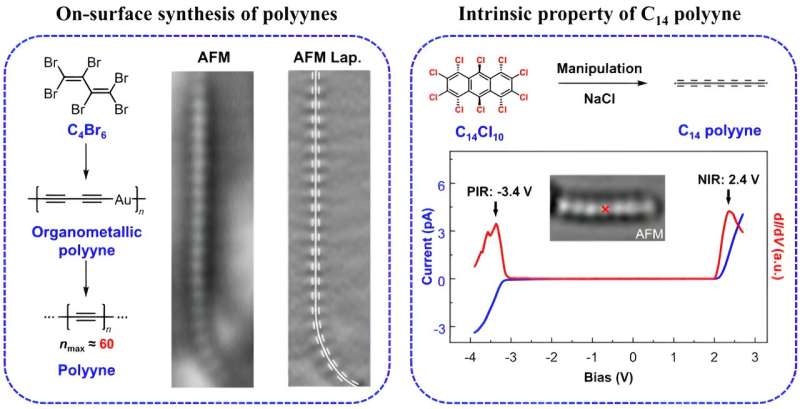This article has been reviewed according to Science X's editorial process and policies. Editors have highlighted the following attributes while ensuring the content's credibility:
fact-checked
trusted source
proofread
On-surface synthesis of carbyne: An sp-hybridized linear carbon allotrope

In a study led by Prof. Wei Xu (Interdisciplinary Materials Research Center, School of Materials Science and Engineering, Tongji University) and published in the journal National Science Review, a research team achieved the successful synthesis of a one-dimensional carbon chain on the Au(111) surface, with the longest chain containing approximately 120 carbon atoms, and the polyynic nature of the carbon chain was unambiguously characterized by bond-resolved atomic force microscopy (AFM).
The creation of new carbon forms with different topologies has emerged as an exciting topic in both fundamental chemistry and materials science. Carbyne (linear carbon chain), an elusive sp-hybridized linear carbon allotrope, has fascinated chemists and physicists for decades. Due to its high chemical reactivity and extreme instability, carbyne was much less explored.
On-surface synthesis is emerging as a promising approach for atomically precise fabrication of highly reactive 1D nanostructures with sp-hybridization that could hardly be synthesized via conventional solution synthetic chemistry. Xu's group employed the on-surface synthesis strategy, utilizing C4Br6 as a precursor, to synthesize polyynic carbon chains on the Au(111) surface via dehalogenative polymerization and subsequent demetallization, and the longest chain consists of ~120 carbon atoms.
Bond-resolved AFM unambiguously revealed the polyynic structure of carbon chains with alternating single and triple bonds.
Moreover, to measure the intrinsic electronic property of the carbon chain, a specific C14 polyyne was produced via tip-induced dehalogenation and ring-opening of the decachloroanthracene molecule (C14Cl10) on a bilayer NaCl/Au(111) surface at 4.7 K. The electronic properties were characterized by scanning tunneling spectroscopy (STS), exhibiting two pronounced peaks at –3.4 V and 2.4 V, corresponding to the positive and negative ion resonances (PIR and NIR), respectively, exhibiting a band gap of 5.8 eV.
This work from Prof. Wei Xu's group provides bond-resolved experimental insights into the structure of the polyynic carbon chains and may open an avenue for the synthesis and characterization of long polyynes without endgroups.
More information: Wenze Gao et al, On-surface synthesis and characterization of polyynic carbon chains, National Science Review (2024). DOI: 10.1093/nsr/nwae031
Provided by Science China Press





















